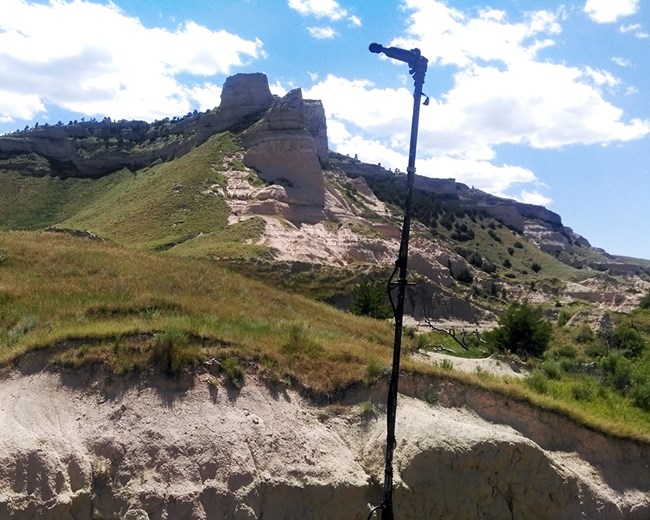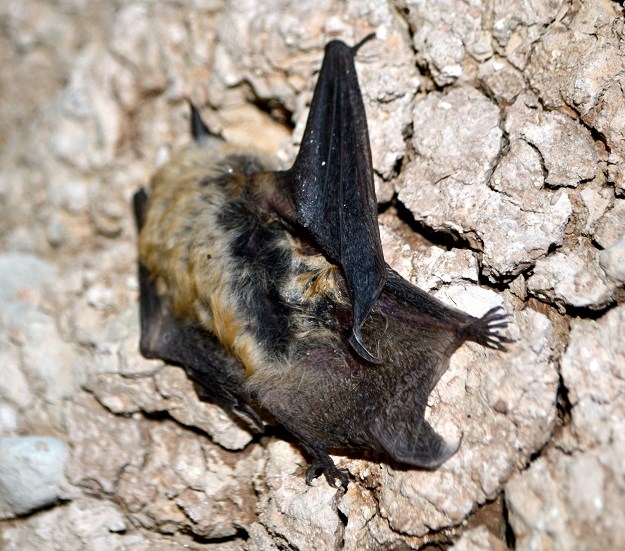Last updated: June 2, 2019
Article
Bat Acoustic Monitoring at Scotts Bluff National Monument

NPS
Overview
Scotts Bluff National Monument is a 3,003-acre park in western Nebraska that conserves the namesake bluff as wells as badlands, prairie, and riparian habitats. The bluffs and the riparian forest along the North Platte River provide good foraging and roosting habitat for bats. Some bats can eat thousands of mosquitoes each night making them important for insect control in the croplands and cities that surround this urban park.
The Northern Great Plains Inventory & Monitoring Network monitors bats to detect long-term trends and to get early warning of undesirable changes in bat populations at the park. A fungal disease called white-nose syndrome is spreading quickly, threatening bat populations in North America. First documented in a New York cave in 2006, this disease is associated with more than seven million bat deaths. It spreads primarily from bat to bat and humans might be spreading the disease by carrying nearly invisible fungal spores on their shoes and clothing from one cave to another. Bat monitoring helps us understand changes occurring with the spread of this devastating disease.
Acoustic Monitoring
Five acoustic recording stations were set up in 2015 and a sixth station was established in 2016: two in riparian forests and four in the badlands/prairie habitats. Acoustic recorders detect the unique ultrasonic calls bats use for echolocation. There were 46,860 bat call recordings from stations across all survey nights from 2015 to 2017. The data were analyzed through specialized software programs that make preliminary identifications of the bat species based on individual call characteristics, such as frequency and shape. Some bat species make calls that are similar to other species, which is why researchers with special expertise review the calls and make the final species determinations.

NPS/Isle Royale National Park
Bats at the Park (2015-2017)
| Common Name | Scientific Name | 2015–2017 Status |
|---|---|---|
| Big brown bat | Eptesicus fuscus | Present |
| Eastern red bat | Lasiurus borealis | Present |
| Hoary bat | Lasiurus cinereus | Present |
| Silver-haired bat | Lasionycteris noctivagans | Present |
| Western small-footed myotis | Myotis ciliolabrum | Present |
| Little brown bat | Myotis lucifugus | Probably Present |
| Northern long-eared bat | Myotis septentrionalis | Probably Present |
| Long-legged myotis | Myotis volans | Present |
| Evening bat | Nycticeius humeralis | Probably Present |
| Tri-colored bat | Perimyotis subflavus | Present |
- Hoary bats, silver-haired bats, and big brown bats were the most commonly recorded species, followed by western small-footed myotis and eastern red bat. Hear what a Eastern red bat sounds like!
-
Eastern red bat, hoary bat, long-legged myotis, evening bat, and tri-colored bat were new detections for the park. The eastern red bat is near the western edge of its range at Scotts Bluff National Monument, but the large cottonwoods along the river provide good roosting habitat for this bat.
- Some bats, like the western small-footed myotis, like to roost in crevices in cliffs. The bluffs in the park provide excellent roosting habitat, and western small-footed myotis were commonly recorded in that habitat.
- Riparian areas such as the forests along the North Platte River, had the most bat detections per night. These areas provide excellent bat habitat with old trees for roosting and surface water for foraging and drinking.

NPS/Badlands National Park
White-nose Syndrome
White-nose syndrome has not yet been detected at the park, but the fungus (Pseudogymnoascus destructans) that causes it was detected in South Dakota in 2017 to the north of Scotts Bluff National Monument. See a map of white-nose syndrome in national parks and learn more about how you can help prevent the spread of this fungus. A program is underway at Scotts Bluff National Monument to capture bats and swab them for the fungus. Continued monitoring, and park staff and visitor observations, will help us protect the bat communities that live and forage in the park.
For More Information
Dan Licht, Midwest Region Wildlife Biologist
Protocol Contact: Northern Great Plains Network
Summary by Tani Hubbard, updated in 2019
